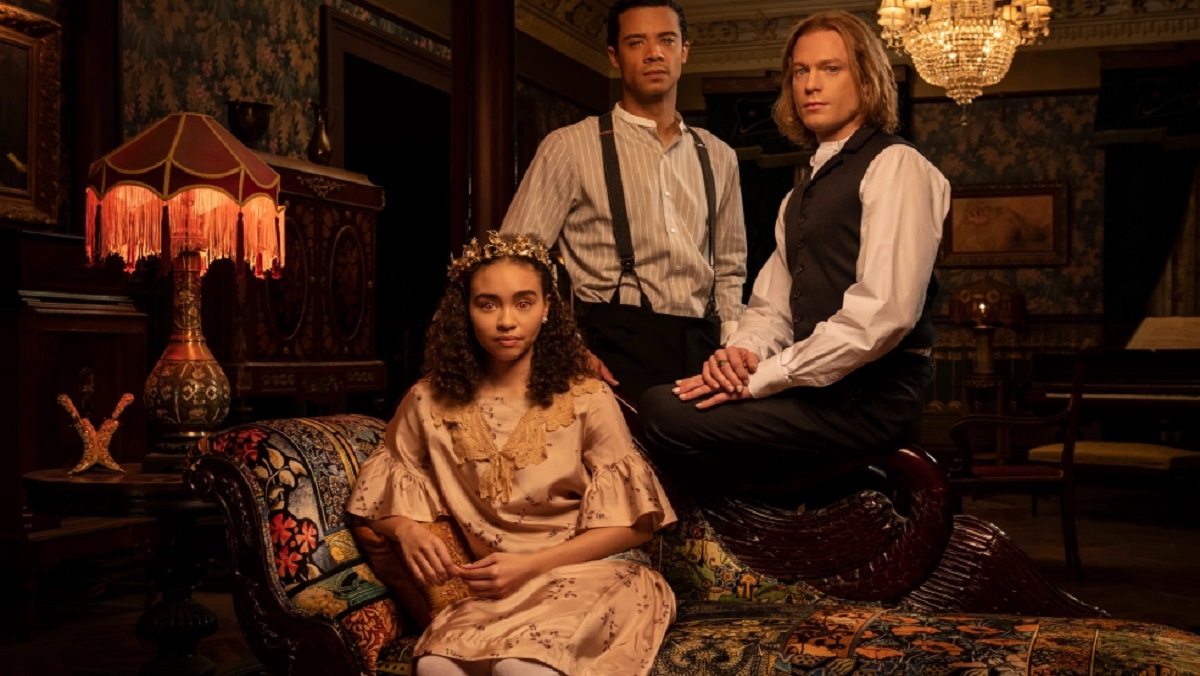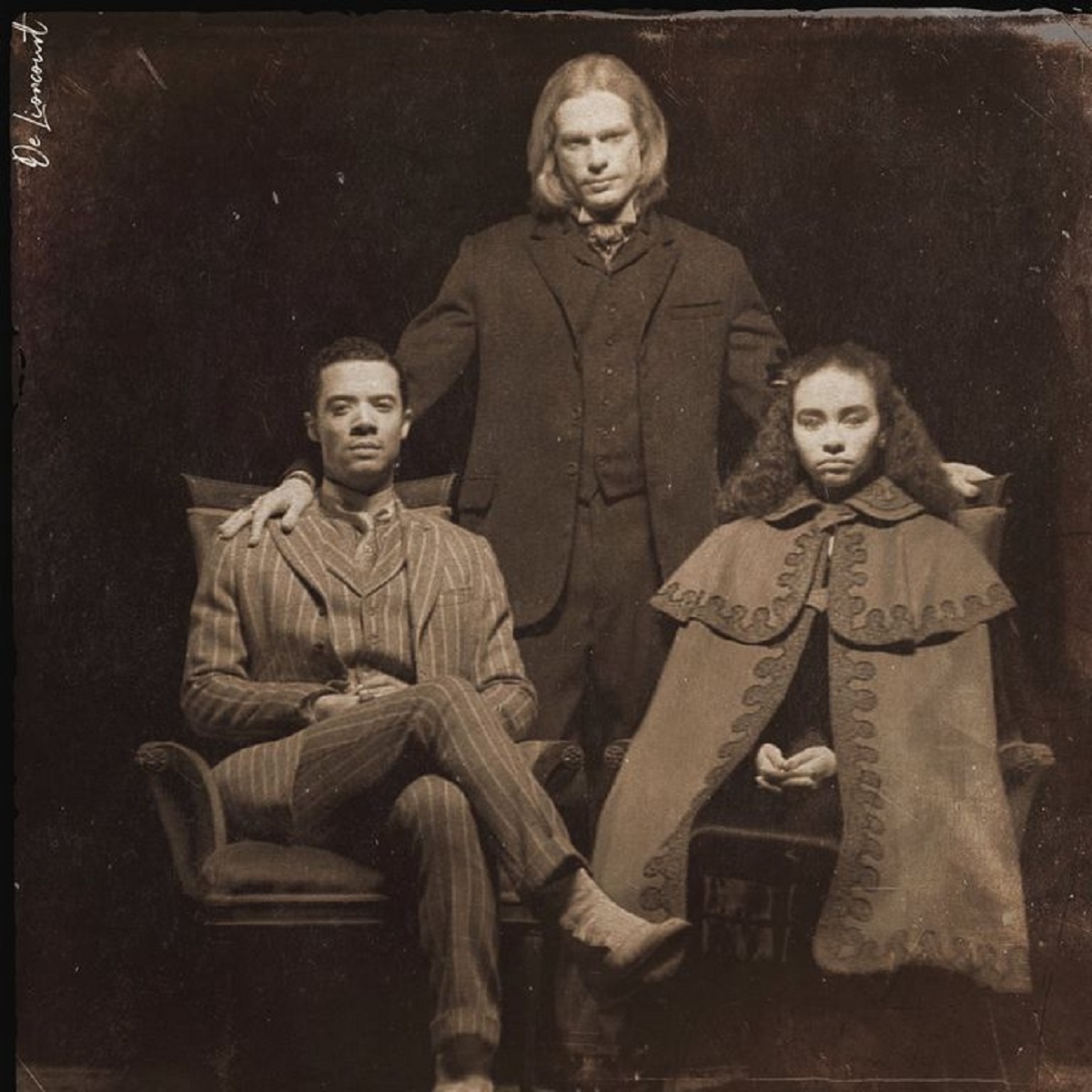AMC’s reimagining of Anne Rice’s Interview with the Vampire has taken several liberties with the source material, but so far, they have all worked extremely well. Both Jacob Anderson and Sam Reid capture the heart and soul of their respective vampires, Louis and Lestat, in a bold re-contextualization of the material. But changes to the time period and other details are one thing. Now the series has fundamentally changed one of its main characters, and to me, this change unfortunately fails that character completely. I’m talking about Lestat and Louis’ undead “daughter,” the vampire Claudia who is quite different in Interview with the Vampire.

“…The Ruthless Pursuit of Blood with All a Child’s Demanding”
In episode four, “…The Ruthless Pursuit of Blood with All a Child’s Demanding,” the producers finally introduced the crucial character of Claudia into the narrative. In Rice’s novel and its film adaptation, she was a vampire trapped eternally in the body of a young child. Now, she’s now a vampire forever in the body of a teenager. And despite the best efforts of talented actress Bailey Bass, they seemed to have missed the point of her character entirely, in one of the show’s first big stumbles.
In an interview with Den of Geek, series producer Rolin Jones said the following about Rice’s child vampire. “Claudia, for me, personally, is her greatest creation. The five-or six-year-old girl permanently trapped in that body is aggressively original.” Rolin Jones also stated, “It was very important for us to shoot in New Orleans, where child labor laws say your actor can only work so many hours.” I guess these laws were not a thing in 1994 when the movie was made. But regardless, there is digital trickery that would have allowed Bailey Bass to play the character as younger. Clearly, they purposefully chose not to go that route. And probably, I feel, for fear of repercussions from bad-faith critics who wouldn’t watch the show regardless.
The Origins of Anne Rice’s Child Vampire

Anne Rice wrote Interview with the Vampire in 1973, following the death of her six-year-old daughter Michelle from leukemia. The book emerged in an alcohol-fueled outpouring of grief, told through the lens of a vampire confessing his life story. By Rice’s own admission, the characterization of Claudia was nothing like her daughter. But the notion of being only a small child forever nevertheless gave life to this character. And despite only being in one novel, the ghost of Claudia haunts Rice’s entire Vampire Chronicles book series.

The TV series completely reimagines the character from a six-year-old girl to a 14-year-old. Now, the 1994 film reimagined her as an 11-year-old (Kirsten Dunst), for obvious reasons. To be blunt, you can’t get a child of 6 to act like an adult. It’s just beyond their capabilities. But a child a few years older can. So what’s the story difference between a 10-year-old Claudia and a 14-year-old one? Simply put, it’s puberty. The rage she feels comes from her forever prison in a small and helpless body, treated like someone who thinks boys are “icky” and only wants to play with dolls, but has an adult mind. This is what made that character so compelling to readers and fans of the movie alike.
Claudia Goes From “Infant Death” to Eternal Adolescence in Interview with the Vampire

In the series,’ Bailey Bass’ version of the character is now a teenager forced into eternal adolescence. Don’t get me wrong, it’s clearly subject matter ripe to cover. Only we’ve seen it before many times, and recently. Twilight, The Vampire Diaries, True Blood, even going back to The Lost Boys. They all dealt with characters made vampires as teens, and who now dealt with eternal adolescent angst (fangst?) Besides, from The Bad Seed to The Ring, simply nothing is more creepy than a demonic child. Teens are mostly just annoying. What made Claudia unique was that what her vampiric parents did to her was far worse. Claudia forced to wear children’s clothing and play with toys for all time is simply a more terrible fate than eternal teenagerdom.
As a teenager, you could theoretically convince someone you were older, simply with clothing and makeup. Claudia wouldn’t have to be eternally tied to her fathers anymore, because she could conceivably take care of herself in the outside world. But as a younger child, she couldn’t rent an apartment or buy a house. In the book and the film, this forced eternal attachment to her fathers makes her bitter and resentful of them. In the Interview with a Vampire series, Claudia displays similar resentments, but they make little sense in the context of what we’ve seen.

The show also seems to want to have their cake and eat it too in regards to her age. Although she’s said to be 14, she acts and is dressed as much younger. Which makes it all seem even more ridiculous, as the actress is clearly a young woman and not a child. A scene in episode four, where Claudia dresses up in grown-up clothes to “pass” as an adult doesn’t help, because all it does is remind the audience that the person playing the character is, in fact, an adult. Bailey Bass gives the part her all, and she should be applauded. But the writing fails her. It’s not on her, it’s on the producers.
Claudia’s Changed Origin Story Undermines Louis’ Character
Claudia’s creation in the series also undermines her relationship with Louis. For a series that seems to want to make everything more explicitly queer, they’ve literally de-gayed one of the book’s most queer aspects. Which is that Lestat and Louis make Claudia together. In Rice’s version, Louis, who has sworn off feeding on humans, has a moment of weakness when he passes by a derelict building with a crying child. It’s there he meets Claudia, lying by her dead mother’s side, herself succumbing to the ravages of the plague.

In a horrible moment of weakness, Louis feeds on her. He tells himself that she would have died regardless (which is likely true). But he chose to take her life, making himself the one ultimately at fault. Lestat then intervenes, against Louis’ wishes, and makes Claudia into a vampire. Louis now feels eternally responsible, despite Lestat doing the actual deed. But as Louis later explains to Claudia, “I took your life. He gave you another one.” This guilt allows the manipulative Claudia to keep Louis wrapped around her finger for decades.
In the series, Louis has no such moment of weakness. Perhaps as way to make Louis less morally gray for TV audiences, they made Claudia a victim of a raging fire who Louis saves, as if her were a vampire superhero like Morbius. The fire is his fault, in an indirect way, but it’s not as compelling as his actually trying to take Claudia as his victim. He then begs Lestat to turn her into a vampire, taking Lestat a bit off the hook morally for what was his most impulsive, selfish act.
Pulling Their Undead Punches

But as twisted as this all is, there is a level of queer wish fulfillment that happens with the creation of Claudia. Two male characters make a child together. They are bound together as her parents, because it took both of them to create her. Yes, the whole thing is disturbing, but it’s supposed to be. Perhaps in fear of public reaction to this story, they neutered it of its power.
Currently, forces of bigotry in the world have taken to labeling all LGBTQ parents as “groomers.” It’s disgusting rhetoric. And probably because of this, there may have been a legit fear from the show’s creators of making Claudia a young child raised by two queer men. Despite the fact that the two men are vampires, which aren’t real, and so not everything they do is a one-for-one comparison to actual living gay people.

Similar reasons kept the movie in development hell during the conservative Reagen ’80s. So, seemingly not trusting the audience, it seems to me they hedged their bets. They cast a woman of 19 as a 14, hoping that would take some of the heat off. But the bigots who would say these things aren’t watching a show about queer vampires anyway. Why cave to what anyone thinks they’ll make a stink over? Why give them the power?
By aging Claudia up, the show’s writers have killed one vampiric subtext that they thought modern audiences wouldn’t go for, presumably for being too disturbing. But in doing so, they created a worse one. With Claudia now a teenage girl, the optics have gone from “Lestat delivers a child to Louis” to “Lestat delivers a child bride to Louis.” We highly doubt the producers intended for this. Ultimately though, that’s what comes across to the audience.
Claudia’s TV Future on Interview with the Vampire
AMC’s series is out now, with a second season already ordered. So in terms of Claudia’s portrayal, there’s not much that Interview with the Vampire can do about it now. Or is there? If they ever do a follow-up series based on Rice’s second novel, The Vampire Lestat, they do in fact have a chance at a “do-over” with Claudia. Remember, everything we learn from Louis is from his point of view. And the show (and the books) have already established that he is prone to rewriting history to suit the moment. It sure would fascinate to find out when we get to Lestat’s confessions that Louis lied about Claudia, her age, and his role in her creation, to make himself look better. That juicy possibility alone has us on board for whatever AMC has in mind next for the character.
The post How INTERVIEW WITH THE VAMPIRE Misunderstands One Crucial Character appeared first on Nerdist.
Source: Keulisyuna
0 Comments